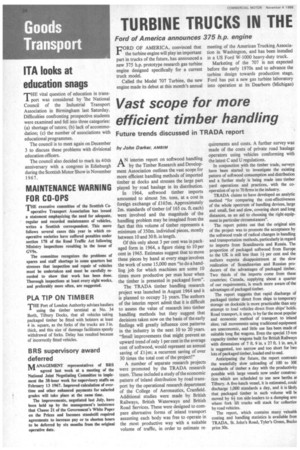Vast scope for more efficient timber handling
Page 36

If you've noticed an error in this article please click here to report it so we can fix it.
Future trends discussed in TRADA report by John Darker, AMB1M AN interim report on softwood handling by the Timber Research and Development Association outlines the vast scope for more efficient handling methods of imported timber at docks and stresses the large part played by road haulage in its distribution.
In 1964, softwood timber imports amounted to almost 5m. tons, at a cost in foreign exchange of £165m. Approximately 2m. standards of timber (of 165 Cu. ft. each) were involved and the magnitude of the handling problem may be imagined from the fact that this volume of timber represents a minimum of 350m. individual pieces, mostly between 10 and 30 ft. in length.
Of this only about 3 per cent was in packaged form in 1964, a figure rising to 10 per cent in 1965. Estimates suggest that to move these pieces by hand at every stage involves the work of some 15,000 men "to do a handling job for which machines are some 10 times more productive per man hour when the timber is presented in packaged form".
The TRADA timber handling research project was launched in August 1964 and it is planned to occupy 24 years. The authors of the interim report admit that it is difficult to assess the value of research into timber handling methods but they suggest that decisions taken now on the basis of the early findings will greatly influence cost patterns in the industry in the next 10 to 20 years. "Small improvements that might prevent an upward trend of only 1 per cent in the average cost of softwood, would represent an annual saving of £ 14m; a recurrent saving of over 30 times the total cost of the project!"
A number of separate research projects were promoted by the TRADA research team. These included a study of the economic pattern of inland distribution by road transport by the operational research department of the College of Aeronautics, Cranfield. Additional studies were made by British Railways, British Waterways and British Road Services. These were designed to compare alternative forms of inland transport assuming each body was free to operate in the most productive way with a suitable volume of traffic, in order to estimate re
quirements and costs. A further survey was made of the costs of private road haulage operators using vehicles conforming with the latest C and U regulations.
In conjunction with the timber trade, surveys have been started to investigate the existing pattern of softwood consumption and distribution and a further study is being made into timber yard operations and practices, with the cooperation of up to 70 firms in the industry.
TRADA claims to have developed an analytic method "for comparing the cost-effectiveness of the whole spectrum of handling devices, large and small, fast and slow, covering short and long distances, as an aid to choosing the right equipment in particular circumstances".
The report points out that the original aim of the project was to promote the acceptance by the softwood trade of radical changes in handling and transportation methods, particularly in regard to imports from Scandinavia and Russia. The proportion of packaged softwood from Europe to the UK is still less than 14 per cent and the authors express disappointment at the slow realization of Scandinavian and Russian producers of the advantages of packaged timber. Two thirds of the imports come from these countries; Canada, supplying about a quarter of our requirements, is much more aware of the advantages of packaged timber.
The report suggests that rapid discharge of packaged timber direct from ships to temporary storage on dockside is more practicable than any attempt to load vehicles direct from ships' holds. Road transport, it says, is by far the most popular and economic method of transport to inland sites; rail movements using traditional equipment are uneconomic, and little use has been made of suitable long flat wagons. Even the special 15-ton capacity timber wagons built for British Railways with dimensions of 7 ft. 9 in. x 27 ft. 1 in. are, it is suggested, too narrow and too short for two lots of packaged timber, loaded end to end.
Anticipating the future, the report contrasts the wastefully slow unloading of 100 to 30C standards of timber a day with the productivity possible with large vessels now under construction ' which are scheduled to use new berths al Tilbury. A five-hatch vessel, it is estimated, couk discharge 1,000 standards a day, and it is likely that packaged timber in such volume will in moved by 64 ton side-loaders to a dumping are.i where fork lift trucks will stack for collectior by road vehicles.
The report, which contains many valuabli costing and handling statistics is available fron TRADA, St John's Road, Tyler's Green, Bucks price 30s.








































































































































































